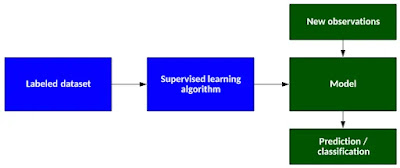Supervised learning
Supervised learning, a fundamental branch of machine learning, has revolutionized the way we solve complex problems and make predictions. By leveraging labeled data, supervised learning algorithms can uncover hidden patterns and relationships, enabling us to gain valuable insights and make informed decisions. In this blog, we will delve into the world of supervised learning, exploring its key concepts, algorithms, and real-world applications.
The Essence of Supervised Learning
Supervised learning operates on the principle of learning from labeled examples. It involves training a model using input data and their corresponding output labels. The goal is to create a mapping function that can accurately predict the output for unseen inputs. This process encompasses two phases: the training phase, where the model learns from labeled data, and the inference phase, where it applies the learned knowledge to make predictions.
Popular Supervised Learning Algorithms
- Supervised learning encompasses a rich collection of algorithms. Linear regression, for instance, is widely used for predicting continuous values, such as housing prices based on features like location, size, and number of rooms. Logistic regression, on the other hand, is valuable for binary classification problems, such as spam detection or sentiment analysis.
- Decision trees and random forests provide a versatile framework for both classification and regression tasks. Support Vector Machines (SVM) find application in scenarios where the data can be separated by a clear margin, enabling effective binary or multi-class classification.
- Neural networks, including deep learning architectures like Convolutional Neural Networks (CNNs) and Recurrent Neural Networks (RNNs), excel in complex pattern recognition tasks, such as image classification and natural language processing.
- Supervised learning has transformed various industries and domains. In healthcare, it enables the development of predictive models for disease diagnosis, personalized treatment recommendation systems, and early detection of medical conditions. In finance, supervised learning facilitates fraud detection, credit risk assessment, and stock market prediction.
- The field of natural language processing benefits greatly from supervised learning, powering applications like sentiment analysis, language translation, and chatbots. In autonomous vehicles, supervised learning aids in object recognition, lane detection, and path planning
- Supervised learning also plays a significant role in recommendation systems, predicting user preferences and suggesting personalized products or content. Moreover, it has found utility in image and speech recognition, anomaly detection, customer churn prediction, and many other domains.
- Supervised learning has emerged as a powerful tool for unlocking insights and making accurate predictions. By leveraging labeled data, it enables us to build models that can learn from the past and generalize to unseen examples. With a wide range of algorithms at our disposal, supervised learning finds applications in various fields, from healthcare and finance to natural language processing and autonomous systems. As technology advances and more labeled data becomes available, supervised learning will continue to fuel innovation and transform the way we approach complex problems.


.jpg)







0 Comments
Refer to a specific part of their comment that you appreciate. Relate to them if you can.